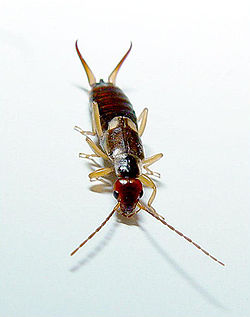| Forficulidae Temporal range: | |
|---|---|
 | |
| Forficula auricularia | |
| Scientific classification | |
| Domain: | Eukaryota |
| Kingdom: | Animalia |
| Phylum: | Arthropoda |
| Class: | Insecta |
| Order: | Dermaptera |
| Suborder: | Neodermaptera |
| Infraorder: | Epidermaptera |
| Superfamily: | Forficuloidea |
| Family: | Forficulidae Latreille, 1810 |
| Subfamilies | |
| |
Forficulidae is a family of earwigs in the order Dermaptera. There are more than 70 genera and more than 500 described species in Forficulidae. [1] [2] [3] [4] [5] [6] [7]
Contents
Species in this family include Forficula auricularia (the European earwig or common earwig) and Apterygida media (the short-winged earwig or hop-garden earwig).
Forficulidae was formerly considered a suborder of Dermaptera, Forficulina, but was reduced in rank to family and placed in suborder Neodermaptera. [5] [7]
